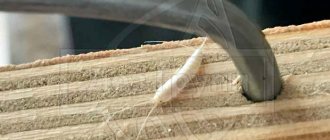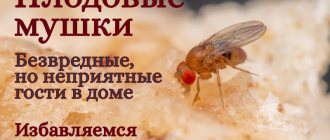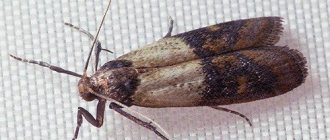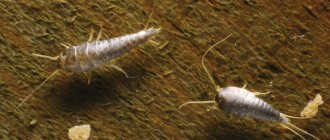Periodically, with the arrival of summer, residents of country houses and city apartments are attacked by poplar moths, which create serious discomfort, but few know how to get rid of it. Insects are common in the European part of Russia; their mass reproduction is observed in years with mild winters and cool summers. Heat, on the contrary, has a detrimental effect on the larvae.
The moth got its name due to the period of its distribution. Individuals can be seen in large numbers during poplar flowering. The females leave clutches of eggs in fluff, which is spread by the wind over long distances.
At night, poplar moths are easiest to spot. When the sun sets and the summer heat of the day subsides, individuals fly into the light in the apartments. Insects accumulate on the ceiling, stick to furniture and other interior items. People are forced to keep their windows closed to get rid of the massive invasion of winged individuals. Poplar moth is not dangerous to humans: it does not carry pathogens of dangerous infections, but it leaves dark spots on the surface of furniture that are very difficult to get rid of. Small insects get into kitchen appliances and lighting fixtures en masse, ruining the appearance. It poses a danger only if people with allergies live in the apartment.
The larvae of urban vegetation cause much more damage. Moth caterpillars feed on perennial poplar, aspen, linden, and maple. They can also damage fruit trees. Whitish inclusions in chrysanthemums and violets are winding passages, indicating that poplar moth larvae have visited the plants. Leaves that have been damaged by caterpillar attacks cannot carry out photosynthesis and turn yellow and fall off. This negatively affects the yield and growth of fruit crops and trees.
Description
Poplar moth (moth) is a nocturnal pest that appears during the active flowering of poplar. It is a small winged insect belonging to a subspecies of butterflies; it can easily enter the house through absolutely any crack or opening.
It is as light as poplar fluff, and with it it can travel long distances.
The poplar moth looks like a small moth. How to recognize it? You need to take a close look at her front wings. They have a clearly visible variegated speckled pattern and a velvety edging – this is the distinguishing feature of the insect. The hind wings of the pest are characterized by a calm steel color. This unusual color allows the poplar moth to be invisible to its enemies.
The wings of an adult reach a length of 7 to 8 mm, with a wingspan of 11 mm. The poplar moth reproduces by laying larvae, which are characterized by a bright yellow color, but gradually, as the insect matures, it becomes bright orange. Poplar moth larvae overwinter in the ground.
During the day, the moth is in the trees, hiding from the sun and other insects and birds, but at night it begins to become active. Adults do not feed: the energy they received while still in the cocoon is quite enough for them.
The most dangerous and voracious are the poplar moth larvae. During the day, the larva feasts on the sweet sap of trees, and at night begins to destroy the leaves. Her diet includes poplar, apple, plum, and pear foliage.
The life of this pest is short and lasts only 72 hours. But even in such a short period of time, an adult, capable of reproducing, lays several thousand eggs, from which larvae hatch after 10 days.
By mid-June, the larvae enter the pupal stage, and after about a month, a full-fledged moth emerges from the cocoon.
Protecting sushi during storage
One of the most common issues that worries almost every beekeeper is the preservation of land from wax moths. To protect frames during storage, it is recommended to periodically check them for the presence of pests, removing them if necessary. The room where dry goods are stored must be well ventilated.
To repel larvae and adult butterflies, it is recommended to use various plants that have a distinct odor, such as peppermint. The stems should be laid out on the bottom of the boxes, on the floor around the frames. You can use ordinary garlic instead of mint, after cutting several cloves into large pieces.
Products of this kind are plates that are completely harmless to bees, but destructive to wax moths. Such plates should be placed strictly between the frames. They should be changed as needed.
What does it look like
The name “poplar moth” is considered conditional. Entomologists classify the insect as a subspecies of the Butterfly family. Because of the characteristic marks that the small pest leaves on the foliage, it is called a leaf miner.
Moths are distinguished by narrow, blade-shaped wings edged with fringe. The front pair is brown with small white and brown contrasting inclusions, the back pair is shorter, steel color. The wingspan of an adult insect (imago) is 6-10 mm, the average length is 5-8 mm. Such colors and sizes make the moth invisible against the background of trees.
Cocoons hide in cracks and crevices of houses, bark, hollows, fall into the ground with fallen leaves and continue to live after wintering. At the end of spring, harmful insects fly out and actively mate.
Photo of an adult moth.
Appearance
What does 1 common mole look like? This moth has a yellow color - gray or dark. A red tint is sometimes visible on the body of this insect.
Such a parasite has 2 pairs of shiny wings that shimmer in the sun. A fringe is visible along its edges. The span of the front wings of such a moth is 9–18.5 mm. The hind wings are more uniform in color and smaller in size.
The chest of such a small pest is brown on top and light yellow and shiny below.
The male of this insect is smaller than the female, and after mating with the female and fertilizing her, he quickly dies. The female of this small pest lives for about 1 month.
How to recognize an insect
The greatest damage from the pest occurs in urban green spaces. The main food is poplar, but the parasite does not ignore other plants.
You can recognize an insect by its characteristic features, including:
- Leaf fall. Moth colonies eat the foliage, causing it to fall prematurely and the branches to freeze. In such cases, many trees die.
- Moves of different configurations. Depending on the type of tree or plant variety, the pestle makes pinpoint punctures, bizarre passages of white and yellowish colors, and grinds off the entire surface.
- Through holes in young leaves (mines). The caterpillars choose a place for pupation in fresh greenery, eating large holes with a diameter of 1.5-2 cm.
- Spots on the crown. Damaged plates quickly turn yellow, fade and fall off.
Habitat, lifestyle and nutrition
In nature, the moth lives in those areas where balsam, fragrant, pyramidal poplars grow:
- in the European part of Russia;
- on the territory of the Caucasus;
- in the Central Asian region.
Adults do not feed. They live off what they have stored while in the caterpillar stage. But the larvae are distinguished by their extraordinary gluttony. They eat young leaves:
- drain;
- pears;
- apple trees;
- poplars and other trees.
Just one larva can gnaw a hole with a diameter of about 2 cm in a leaf. If there are many pests, the trees may be left without foliage as early as July-August.
Pest
Penetrating into a person’s home, butterflies settle in chandeliers, lampshades, electrical appliances, containers with bulk products, and dried fruits. They also love various secluded places - behind furniture, radiators, etc.
Life cycle and reproduction
An adult moth lives about 60-70 hours. During this time, the female is able to lay eggs 2-3 times. The best environment for their development is poplar fluff, last year's foliage, quiet dry corners in residential and non-residential premises. Within 7-10 days, larvae about 5 mm long will form from the eggs. They penetrate the leaf plate and cover the entrance with a special shell.
Thanks to increased feeding on green leaves, the larvae grow quickly. During the first two stages they do not have legs.
Each larval stage ends with a molt. At the third and fourth stages of development, the larvae change color from light yellow to orange. During the same period, they develop abdominal and thoracic legs, and the larva turns into a caterpillar.
After 8-9 days, the caterpillar again changes color to a shiny brown. Her abdominal region takes on a pointed shape - the first sign of the onset of pupation. At this time, the body length of the caterpillars is about 4 cm.
After a week or a week and a half, a butterfly emerges from a fully formed cocoon. This happens at the end of July or August: the mass emergence of butterflies occurs over the course of a month and a half. At the beginning of September, butterflies leave for the winter.
In the spring, as soon as warm days arrive, butterflies move from their shelters to tree trunks. Then the development cycle repeats again.
Harm from poplar moth
Moth caterpillars feed on leaves of flowers, shrubs, fruit and ornamental trees. Insects of this species are pests, and they are being combated.
The poplar moth is not dangerous to people. Spotted moths do not spread diseases and do not spoil clothing or food. The main trouble from living in the house of these insects is difficult to remove marks on upholstered furniture and an allergic reaction in both children and adults. In addition, if there are a lot of pests, they get into household electrical appliances and lay eggs inside.
Stages of reproduction
One complete phase of the poplar moth life cycle is 2-3 months:
- Mating occurs in mid-spring.
- In May, the female lays alternately up to 32 eggs on the underside of last year's leaf. The eggs are oval in shape, flattened at the edges, covered with the secretion of the gonads. They have a rough texture, matte, with a diameter of 0.2-0.3 mm.
- In 1-1.5 weeks, larvae form, which climb into the leaf plate and are covered with a thin film. At this stage of development, they vigorously eat greens, accumulating the necessary nutrients.
- After 2-3 days, young caterpillars 3-5 mm long hatch. The shape of their body is transformed 5 times - from legless and pale, the caterpillar turns first into white, then into lemon with 2 pairs of legs. Eats only fiber.
- A loose cocoon of cobwebs forms in the through hole. The development stage lasts from a week to 10 days. The sharp cocoon of a light brown hue reaches 4-5 mm in length.
- From late July to early autumn, the pupae turn into butterflies and live for 3 days.
Stages of moth reproduction.
Each adult strives to lay as many eggs as possible. Suitable places for breeding are bags of flour, cereals and dried fruits.
What species threaten the garden?
In total there are more than 30 species of moths. Many species live in our apartments and populate wardrobes. But we will talk about creatures that pose a direct threat to plants in the garden.
| View | Description | Peculiarities |
| Potato. | The butterfly is gray-brown in color with a wingspan of up to 12-13 mm, the size of the insect at rest is only 7-8 mm. | The larvae eat tunnels in potato tubers and lead to the death of the fruit. |
| Onion. | Brown color with large white spots, elongated body with visible drooping. | Reproduction occurs in May, insects lay eggs on the back of the leaf, and the caterpillars actively destroy the leaf mass. |
| Cabbage. | Large in size, up to 12-16 mm long, with a wide stripe of white or yellow color running along the wings. | Green caterpillars eat cabbage heads, making long strokes in them and leading to the death of the fetus. |
| Tomato (mining). | A butterfly up to 5-7 mm long, with a wingspan of up to 10 mm, beige in color with brown spots. | The caterpillars attack tomato varieties, potatoes, peppers and eggplants. |
| Apple (ermine). | The butterfly is white with noticeable black dots on the wings. | It poses a danger to all types of garden trees, eating leaves and gnawing fruits. |
| Grape (circle). | Small in size with a wingspan of only 3.5-4 mm, brown in color with light-colored spots. | Caterpillars destroy grapevines. |
| Wax (bee moth). | The moth is large in size, up to 35-38 mm in length, gray-brown in color with dark spots. | The larvae can destroy all beekeeping products - royal jelly, bee bread, propolis, honey and even pollen. |
| Poplar. | A butterfly with narrow, velvety, whitish wings with dark spots on the front legs; the wings are framed with downy fringe. | The caterpillar poses a threat to all green spaces, both shrubs, trees and flowers. |
| Rowan (variegated). | The moth is 7.5-8 mm in size and grayish in color with visible dark stripes on the wings. | Causes damage to many garden cultivated trees, affecting foliage and fruits. |
| Currant (bud). | The butterfly is small in size and reaches a length of up to 12-16 mm and is yellowish-brown in color. | Eats plant buds, leading to their death. |
All varieties of moths cannot tolerate low temperatures and die when the temperature drops below +20⁰C.
What does it eat?
Damage to vegetation is caused by the poplar moth larva. She eats fiber from tree leaves. On the damaged surface, a mine is first formed - a hole up to 2 cm, and then only a through hole with a loose cobweb cocoon remains. Insects operate in swarms and are capable of destroying an entire leaf in a few seconds. During periods of mass reproduction, tree baldness is sometimes observed.
The preferred source of nutrients is poplar leaves. After leaf fall, insects can eat linden bark. The larvae also do not neglect other plants:
- pears, apple trees and fruit bushes;
- maple, aspen;
- roses, rhododendron, chrysanthemums and other flowers;
- lettuce, cucumbers.
Interestingly, the moth leaves different marks on each plant. On damaged pear leaves you can find brown passages, on apple trees - intersecting paths, on roses - curly patterns and through dots, on cucumbers and violets - narrow paths and whitish dots, and rhododendron is completely eaten by the poplar moth.
What does an adult eat? She does not need food, but uses up the nutrients that she stored during the larval stage. Her main task is to lay the maximum number of eggs in 73 hours.
Position of entomologist scientist
Several years ago, the capital’s press published many publications about how citizens of Moscow and the region were being attacked by poplar moths. Without exaggeration, there were hordes of this insect on the streets. On pedestrian paths, round “carpets” were made from this insect. Without a doubt, there were absolutely these butterflies in buildings, both residential and public. In this case, citizens noticed that “the creatures are easily harassed by crawling along the body.”
Poplar moth in larval formation
Entomologist Gennady Lyubarevsky, a candidate for biological sciences, commented on the situation: “It is difficult to explain in simple terms such a rapid rise in the poplar moth population. All sorts of factors can have an influence, including atmospheric situations and the presence of a lot of food. Most likely, in this example, it means both location and something else, which led to the quantity output.
Firstly, poplars—dark, laurel-leaved, and balsam—are affected by such insects. But, if the population is huge, then trees of other species are not neglected. More often than not, homeowners and dilapidated buildings suffer from the invasion of this parasite. Insects spend the winter there on balconies, in hallways, attics and basements.”
Reasons for appearance
Many people wonder where food moths come from in a house where regular cleaning is carried out. She cannot accidentally get into the apartment from the street, since she is not capable of flying that well. Those butterflies that flutter indoors are males. Female moths move much more slowly, mostly hopping from place to place. Therefore, even if a male individual has flown into a dwelling, it will not be able to reproduce without a female one.
Inside the bags there are already eggs or moth caterpillars, which then spread throughout the apartment. They get there through cuts, tears, punctures in the packaging or during packaging of goods at the factory.
Comfortable conditions for the reproduction of food moths are a temperature of 22...25°C and air humidity above 60%.
Where does the poplar moth live?
There are many nocturnal inhabitants found in nature. This variety is most common in the Caucasus, in Central Asian countries (Kazakhstan, Uzbekistan, Kyrgyzstan, Turkmenistan, Tajikistan) and in European Russia.
The parasite prefers regions where balsam, pyramidal, sweet-scented and laurel-leaved poplar grow, and avoids areas with black and Canadian poplars. Leaves wild forests unattended.
On the South American continent there is a large subspecies with a wingspan of 7 cm and above.
Habitat of the poplar moth.
Thanks to their coloring, insects are invisible during the daytime. In the evening, they gather in the light of lanterns, cover the ceiling, fly into open windows, into entrances, and land on people.
Unwanted guests do not allow the home to be ventilated. Colonies of the moth quickly fill electrical appliances, chandeliers and lampshades.
White fluff is a favorable environment for the parasite to reproduce. The summer heat protects against the growth of pest numbers. Cool summers and warm winters, on the contrary, contribute to an increase in the population and lead to sharp surges in numbers and invasions.
Preferences
Usually a single generation is born. The masonry of the second stage dies with the onset of autumn frosts. However, in mild climates and under optimal conditions, successful growth of several generations is possible.
According to the observations of scientists, moth poplar abundantly populates balsam poplar, slightly less poplar and fragrant poplar. Almost completely avoids black and Canadian. She also does not favor wild forest areas. By causing premature leaf fall, the pest disrupts the subsequent growth of plantings. Especially great damage is caused to closely related crop species in greenhouses and nurseries. They are unable to grow, bear fruit, or reproduce normally. Further deterioration in viability leads to death.
Do poplar moths bite?
The moth cannot bite a person; it can only cause psychological inconvenience and disrupt the cozy and comfortable atmosphere of a house or apartment.
Is it dangerous for humans?
The parasite is not dangerous to human life or pets.
Poplar moth is absolutely safe for humans.
Poplar moth, unlike rodents (rats, mice) and some insects (lice, mosquitoes, flies, bedbugs), is not a carrier of severe infectious diseases, and therefore does not harm health.
Having flown into a room, moths do not spoil clothes and food, but leave marks that are difficult to remove on furniture and home textiles.
Electrical installations, equipment and lighting fixtures suffer from moth infestations. Insects flock to the light, get into chandeliers and lampshades, and lay eggs in equipment, damaging and dirtying it.
Preventive actions
Do you carry out moth prevention in your garden?
Constantly! I want to start
All varieties of moths are united by a common factor - this is the stage of development of the insect in the form of a pupa. Females lay eggs in the top layer of soil or on tree bark
Therefore, the most important measure is thorough autumn digging of the soil and regular cleaning and bleaching of tree trunks
All plant debris (leaves, fallen fruits and tops) are removed and then burned. Skeletal branches of trees are washed with special hard brushes (they scrape off clutches of moth eggs).
If insect larvae and eggs are found on young plant branches, they must be removed and burned.
Helps get rid of garden moths and birds. They should be attracted to the garden by birdhouses and feeders with regularly replenished food supplies. Starlings especially love to feast on the larvae and caterpillars of the parasite.
Garden moth is a dangerous pest. The greatest damage is caused by moth larvae and caterpillars. If you detect even minor manifestations of infection and individuals fluttering in the garden, you must immediately begin the fight against this voracious and omnivorous pest.
- Lacewing: description of the insect, overview of the benefits on the site and in the house, how to get rid of it in the apartment
- How to get rid of mosquitoes on your property, an overview of the main methods: insecticides, repellent plants, devices, treatment, traditional methods, the pros and cons of these options
- How to get rid of cabbage butterflies: what it looks like, what it prefers, an overview of mechanical, chemical and folk methods of control, their pros and cons
- How to deal with carrot fly: description of the pest, signs of infection, what crops it affects, review of chemicals and traditional methods, prevention tips
Signs of plant damage
The fact that poplar moths have appeared on the trees can be understood by the fact that traces of the vital activity of caterpillars appear on their leaves. Their shape depends on the type of wood:
- On the leaves of apple trees, the passages can be round or serpentine.
- Brown or beige marks appear on pear leaves.
- Small holes appear on rose leaves.
- Light passages and dots are visible on damaged lettuce and violet leaves.
- White dots can be seen on cucumber leaves.
- Light-colored zigzag marks will appear on chrysanthemum leaves when infected.
General actions for pest control
The first step is to do a general cleaning of the apartment. Surfaces are wiped with a cloth moistened with any detergent. Particular attention should be paid to hard-to-reach places behind furniture and in corners. It is advisable to wash curtains and furniture covers, and treat cracks and holes with a vinegar solution.
Some housewives deal with the problem mechanically, removing moths with a vacuum cleaner. It is very convenient to use a car vacuum cleaner - it is small and light. Although the method is effective, complete elimination of larvae and eggs cannot be guaranteed. After cleaning, the bag with the collected pestra should not be thrown into a trash bag - it is better to burn it on the street.
The most popular moth repellent is a mosquito net installed on the windows.
The net will help not only against moths, but also against flies, wasps, and mosquitoes. The main thing is to install it correctly. It is better to contact specialists, otherwise purchasing a mesh will not bring the expected result. To attract pests, you can turn on incandescent lamps near the nets.
Traps with an adhesive base will help destroy adult individuals. You need to hang them in places where moths have been noticed and change them from time to time. Flocked to the tempting smell, the insects will stick to the traps and will not be able to reproduce. You can also use pyrethrum based products.
If a moth is found in a greenhouse, you can add a predator that feeds on it - an ichneumon wasp.
You can destroy moths in a private house with the help of major repairs. It is necessary to clear the floors, replace or treat the walls, which provide ideal conditions for the breeding of insects.
Places where pestra accumulates can be treated with Dichlorvos, Butox, veterinary remedies for exoparasites. They will help remove pestra and phytoncides. Having noticed insects, you need to clean the apartment and treat all surfaces with a vinegar solution.
You can get rid of moths using heat. The room where the insects have settled can be frozen out or treated with a steam generator. Adults and larvae will die.
Folk remedies
Before using harmful chemicals, you should try to remove insects from your home using safe methods - traditional ones. You need to study the methods in advance, choosing the one that suits you. It is worth remembering that folk remedies will not kill, but will only scare away the pest, so they must be used in combination with mechanical methods (for example, using a vacuum cleaner).
Various plants and herbs have a depressing effect on pestra. You can make a wreath or broom from the following plants:
- sagebrush;
- tansy;
- lavender;
- rosemary;
- mandarin.
Herbs can be put in fabric bags and scattered around the apartment. If there are too many moths, this method will not help.
Poplar moths do not like the smell of cedar essential oil, so it is used to make home remedies
The smells of essential oils - cedar, wormwood, eucalyptus, tea tree - have a deterrent effect. They can fill the phytobarrier and place it in the place of greatest concentration of moths. The capacity needs to be renewed every month. This will not only get rid of poplar moths, but will also give the room a pleasant aroma. You can place dry lavender branches, strawberry-scented soap, and orange peels in dark places.
Previously, housewives made pestra cubes, laying them out throughout the apartment.
To prepare them you will need:
- a few drops of lemon oil;
- detailed cedar bark - 115 g;
- myrrh - 115 g;
- cinnamon - 115 g;
- soap powder - 35 g;
- a few drops of alcohol;
- ground black pepper - 115 g.
The ingredients are mixed, alcohol is added until a sticky mass is formed. The resulting composition is used to make cubes that are laid out behind curtains, near windows, and household appliances.
An easier way to prepare cubes is to take 500 g of alabaster, add 50 g of ground black pepper, and pour in 40 g of naphthalene. Alcohol is added to the mixture until a ball is formed. They are scattered throughout the housing.
A sachet against moths gives an excellent effect. To make it, you will need to take 500 g of lavender, 1.9 kg of camphor, 30 ml of lavender ether. They are mixed, finely chopped and placed in boxes or bags.
You can make paper with an insect repellent scent.
To do this you need to mix:
We advise you to read:
How to deal with the smell of sweat
- 25 g camphor;
- 15 ml cedar oil;
- 25 g phenol;
- 350 ml gasoline or kerosene.
When preparing the mixture, you must follow safety precautions, as it is flammable. Some components are harmful to pets, so it is better to give your pets someone to look after during the procedure.
If pestra is noticed on indoor plants, they need to be treated. You can use a solution of laundry soap. Pieces of soap with the scent of citrus, mignonette, and lily of the valley can be placed in places where moths are spotted.
The insect does not like the smell of cedar, lavender and cloves, lemon, orange. If you buy flavors with these aromas, there will be significantly fewer individuals. You can soak tampons with essential oils of plants and place them in inconspicuous places in your apartment. Instead of orange essential oil, you can use fresh fruit peels. As they dry out, about once a month, they will need to be replaced with new ones.
Indoor plants will help drive away moths. Insects cannot stand proximity to geraniums, tobacco and nettles, so it is advisable to place them on windowsills. The smell of leaves will scare away unexpected guests - pests will not be able to enter the home through the windows.
Tobacco in a fabric bag is another effective means of repelling poplar moths. It needs to be laid out on the window sills and on the floor. Having sensed a pungent odor, insects will not stay in the apartment for long.
Dried chestnut fruits will also help you forget about the unpleasant problem. They are laid out in places where moths are spotted.
Important! When using folk remedies, you need to remember that they help scare off adult moths; you will need to get rid of the larvae using more radical methods.
Where to go for help
Spotted grass is a dangerous pest along with ticks and bark beetles. Parasitizing urban green spaces and garden crops, it causes premature leaf fall and impairs the viability of trees.
Citizens complain to various authorities. To clear a large number of plants on which the pest lives, it is recommended to draw up collective letters of complaints to the territorial prefectures from residents of the block or entrance.
Based on the application, the city authorities assign special groups that assess the condition of the trees. Based on the results of the inspection, utility services treat plants with insecticides, cut off affected branches, or cut down poplar groves and plant new varieties.
Methods of destruction
There are no special means that would destroy the moth once and for all, so the question of how to deal with poplar moth continues to be relevant.
Experts in this field most often propose a radical way to solve the problem - massive cutting down of poplars and planting instead of them trees that are more resistant to poplar moths.
How to get rid of larvae
An adult poplar moth lays eggs once every 24 hours. Poplar moth larvae emerging from laid eggs develop dynamically. To completely get rid of such an insect, it is necessary first of all to eliminate the larvae.
You can do this as follows:
- Treat the suspected location of the larvae with special paraffin-based products.
- Use entomophages (beneficial insects). The greenhouse or vegetable garden is inhabited by riders, namely individuals that destroy pest eggs.
- Use pyrethrum-based insecticides. Manufacturers obtain this natural insecticide by grinding dried Persian or Caucasian chamomile flowers.
The peculiarities of the poplar moth and the fight against it are that any actions should be performed before the fluff appears.
Destruction of moths in the apartment
Quite often, such a pest enters the living quarters of houses or apartments.
Below are ways to get rid of poplar moths in an apartment:
- You can protect your living space from the penetration of poplar moths by installing mosquito nets that have small cells on windows and doors, or you can use gauze cloth. Such materials serve as an excellent barrier.
- Install fumigators in the room, which are compact devices that operate from a standard electrical network and consume 4-5 W of electricity. The insecticide can be filled in the form of plates or a vessel with liquid. Such devices are harmless to people and pets.
- If the moth has laid eggs in hard-to-reach places (cracks, joints), then use a vacuum cleaner or similar device to remove them.
- Moth aerosols are considered the most effective against butterflies flying around the apartment. The active ingredient in sprays can be an insecticide with enteric contact action or nerve agent action. It is guaranteed to completely destroy flying and crawling insects.
In addition, traps are installed in residential and utility rooms, the inside of which is treated with an adhesive composition.
Types of funds
It is impossible to achieve complete disappearance of the pest in one go. Many areas are addressing the problem ahead of time. In the fall, fallen leaves are destroyed, and in the spring, the crowns, trunks and tree trunk areas are sprayed with chemical compounds.
It is recommended to choose poisons with caution.
Urban landscaping uses plants that attract natural moth regulators. Entomophages eat up to 60% of moths.
In addition to preventive measures, the following chemicals and poisons are effective in combating the poplar moth population in urban environments and garden plots:
- Numerous clutches of eggs and caterpillars are destroyed by compounds that contain paraffin or karbofos. The drugs are ineffective in removing adult moths. Toxic substances can damage other crops; the proportions specified in the instructions must be strictly observed.
- Safe insecticidal mixtures of pyrethrum (Caucasian chamomile) in liquid or powder form are used against caterpillars and butterflies. A fast-acting composition without a strong odor has a paralyzing effect. Diluted and applied in the morning or evening up to 7 times per season, with breaks of 4-6 days. To destroy the pupae, the solution is poured into the ground.
Tree processing.
Since insects quickly adapt, are highly resistant to many poisons and are not afraid of pesticides, it is recommended to alternate drugs or combine them.
With numerous outbreaks, the number of miners is reduced in a radical way - poplars are cut down and other tree species are planted.
Chemicals
Poplar moth can be controlled using chemicals and toxic substances. The active components act on adult parasites. Larvae and pupae can continue their development.
To minimize harm, you should give preference to products with paraffin.
Poisons should only be used if the area is severely infested. It is important to follow all safety precautions. It is recommended to carry out the manipulation in the morning and evening hours 5-6 times every 3-5 days.
Moreover, the moth dies after the initial treatment, and the procedure must be repeated several times to destroy the larvae. If pupae are present, such insecticides are useless. To get rid of them, you need to water the soil with a solution of pyrethrum.
Folk remedies
If a poplar moth appears, experienced summer residents know well how to deal with it.
They offer these options:
- If moths make themselves known in greenhouses, then you can use their natural enemy - the parasitic insect. Depending on the species, it will fight with adults or larvae.
- It is recommended to inspect the plant for pests as often as possible. Already damaged leaves should be cut off and destroyed.
- If the plant is undersized (cucumbers, flowers), then it can be covered with a non-woven fabric. This is done to prevent the moth from laying eggs.
It is possible to save the leaves of the plant if you spray them with pyrethrum-based preparations. This must be done quite often with a short time interval.
Chemicals
Anti-flying insecticides will help against pestra. They must be used carefully, remembering that insecticidal aerosols are harmful to health, especially for people with allergies.
In addition, they spread an unpleasant odor. Aerosols are used as follows:
- All surfaces are treated with the product, including cabinets, cabinets, and household appliances.
- After waiting a couple of hours, the furniture is wiped with detergent.
- The room is well ventilated.
Among the sprays, the following are highly effective:
- Extramit. By spraying the product, you can forget about moths for six months.
- Clean house. Used in small houses, it helps to quickly get rid of adults and kill larvae.
- Armol. Does not harm furniture and destroys butterflies at all stages of development.
- Raptor. Has a pleasant lemon scent. Safe for people.
Fumigators are widely used against moths. They do not affect people or pets, but they do kill insects. The most popular products are Reid, DiK-3, Mosquitoll. They show results over large areas and are effective against most types of moths. Before using the fumigator, you should assess the degree of infection of the apartment. If it is high, it is better to resort to more effective methods.
When you turn on the electrical device, the plate with a specific anti-moth composition begins to heat up. Aromatic fumes affect the respiratory tract of insects and the chitinous coating, provoking the death of not only adults, but also larvae. They act more slowly than sprays. The plates help get rid of insects in a few days or weeks, depending on the severity of the problem.
In the store you can purchase chemical repellents for harmful insects in various forms, including aerosols.
Sections are another popular remedy that will help drive away moths in an apartment. They are hung on walls or in closets. The substance contained in the drug kills butterflies, but does not harm the eggs. Sections based on essential oils diffuse a pleasant aroma of herbs or fruits into the room.
After using them, it is advisable to ventilate the room, but you must first install mosquito nets to prevent the entry of new insects.
It is recommended to spray chemicals in May, when the moth is active and ready to reproduce. Insecticidal coils that repel pests have a good effect. They are installed in loggias and on balconies. Instead, you can use scented candles that contain poison.
Various tablets and briquettes are produced against moths, which are placed in places where insects accumulate. The vapors they emit prevent insects from laying eggs. Although the products are effective, in high concentrations they are dangerous to human health.
Tablets can be attached to the top of the wall. They will repel insects, preventing them from laying offspring. It is better not to be in the room while the tablets are in effect, and after using them you need to thoroughly ventilate the room.
Important! When using chemicals, it is important to read the instructions - each drug has its own algorithm of actions.
Destruction of butterflies on the street
With the onset of autumn cold weather, the moth will disappear on its own, it will simply hibernate, and the remaining caterpillars will pupate and wait for the onset of spring.
To reduce their spring emergence, it is necessary to take a number of measures:
- Spraying plants and the soil around them with pesticide solutions.
- But simple pesticides will not destroy eggs and pupae, so use paraffin-based poisons, which envelop them in a dense shell and prevent further development.
- Treatment should be carried out in the morning or evening, but make sure that the chemical does not get on the fruit.
- If a moth is seen in a greenhouse, and this is not uncommon, then it is known that an ichneumon beetle is actively fighting it. They are specially placed in a greenhouse. Even in the greenhouse, the plants can be covered with a thin, breathable fabric to prevent the butterfly from laying eggs. After complete destruction, remove the fabric.
- Caterpillars die from products containing pyrethrum. But the work should be done several times, since the activity of this component is low.
- If there are not many affected plants in the garden, you can make sticky traps. To do this, paper is glued onto small boards and coated with a viscous substance. During the flight, the moth will stick to such a structure and die.
- Small plants can be sprayed with a solution of water and spring oil.
If the extent of the damage is not large, then regular inspection and collection of leaves will also help eliminate the problem, but in this case there remains the risk of eggs hidden in the thickness of the foliage. Such control measures are necessary when fruit trees and poplars grow under your window and the butterfly can enter the room at any time.
Preventing moths
To avoid encountering the problem again, just follow simple rules:
- Housing needs to be cleaned regularly and things need to be taken care of.
- It is better to throw away clothes that are not worn for a long time.
- Every year you need to check the condition of pillows and blankets. They can be treated with a steam iron and ventilated in the air.
- Moths are attracted to greasy stains. Before summer, seasonal items should be washed, steamed, or dry-cleaned to reduce the likelihood of insects appearing.
- After washing, it is advisable to put things in vacuum bags.
- Bulk products are best stored in airtight containers. You can't leave leftover food in sight - you need to put it in the refrigerator.
- Moths prefer high humidity and lack of ventilation, so the apartment must be regularly ventilated.
- Insects do not like bright light - it is desirable that the apartment be bright.
- Having noticed that moths appear in the apartment every year, tablets, sections, and briquettes should be used as preventive measures.
In the fight against poplar moths, the same measures are used as against mosquitoes and flies. If independent attempts to get rid of it are unsuccessful, you should turn to professionals. Experts eliminate moths not locally, but with the help of a water suspension that penetrates into hard-to-reach corners of the apartment. This ensures complete destruction of pests.
Why does she appear
Knowing the factors that can contribute to the colonization of a hive by moths, it is easier to prevent such an unfortunate event. This can lead to:
- unsuitable location of the apiary, for example, high humidity in this area;
- weakening of the health of bees and therefore their inability to protect their home;
- the absence of a uterus in the family, which manages all natural processes within the family;
- unfavorable hygienic condition of the evidence before moving in (if there are remains of beekeeping products from previous seasons on the honeycombs, and moth eggs have overwintered in the crevices);
- hot microclimate in the place where the hives are stored. This can lead not only to the preservation of the viability of the eggs, but also to a subsequent increase in fertility;
- untimely removal of bee corpses, the presence of which serves as a provoking moment for the appearance of larvae.
Beekeeping is a fascinating but troublesome process. After all, all its products are healing and beneficial to human health. Therefore, it is worth learning to cope with situations such as the colonization of a hive with wax moths. Better yet, learn how to prevent them.











